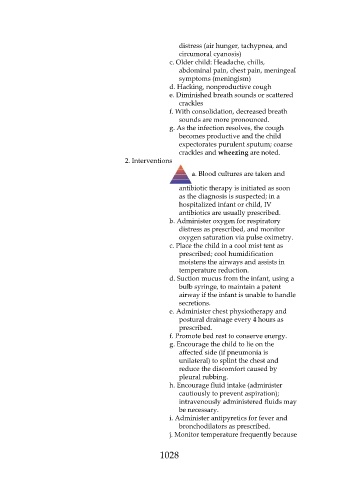Page 1028 - Saunders Comprehensive Review For NCLEX-RN
P. 1028
distress (air hunger, tachypnea, and
circumoral cyanosis)
c. Older child: Headache, chills,
abdominal pain, chest pain, meningeal
symptoms (meningism)
d. Hacking, nonproductive cough
e. Diminished breath sounds or scattered
crackles
f. With consolidation, decreased breath
sounds are more pronounced.
g. As the infection resolves, the cough
becomes productive and the child
expectorates purulent sputum; coarse
crackles and wheezing are noted.
2. Interventions
a. Blood cultures are taken and
antibiotic therapy is initiated as soon
as the diagnosis is suspected; in a
hospitalized infant or child, IV
antibiotics are usually prescribed.
b. Administer oxygen for respiratory
distress as prescribed, and monitor
oxygen saturation via pulse oximetry.
c. Place the child in a cool mist tent as
prescribed; cool humidification
moistens the airways and assists in
temperature reduction.
d. Suction mucus from the infant, using a
bulb syringe, to maintain a patent
airway if the infant is unable to handle
secretions.
e. Administer chest physiotherapy and
postural drainage every 4 hours as
prescribed.
f. Promote bed rest to conserve energy.
g. Encourage the child to lie on the
affected side (if pneumonia is
unilateral) to splint the chest and
reduce the discomfort caused by
pleural rubbing.
h. Encourage fluid intake (administer
cautiously to prevent aspiration);
intravenously administered fluids may
be necessary.
i. Administer antipyretics for fever and
bronchodilators as prescribed.
j. Monitor temperature frequently because
1028

